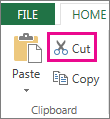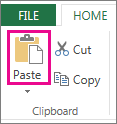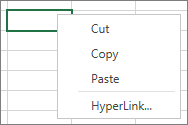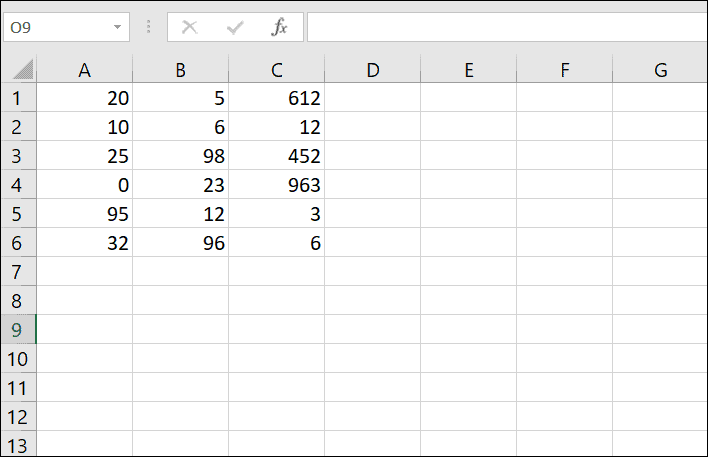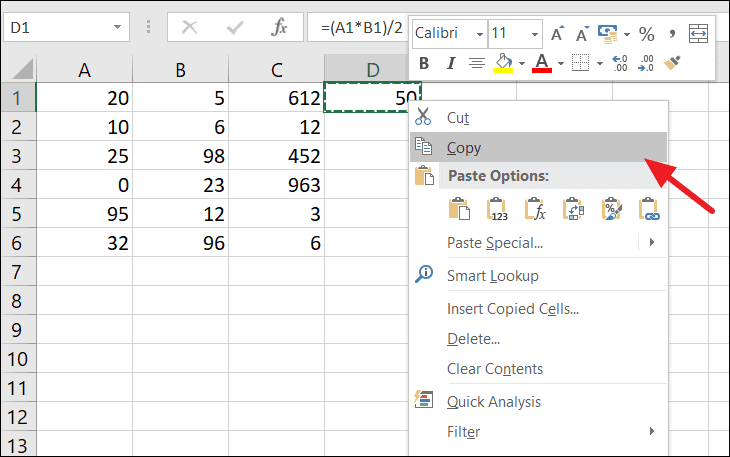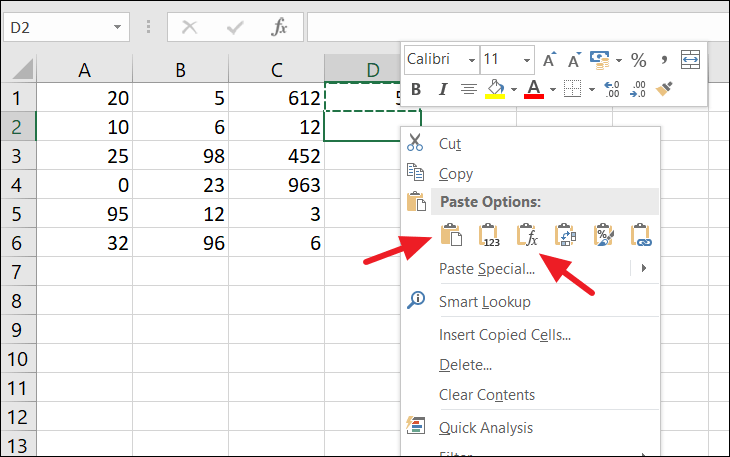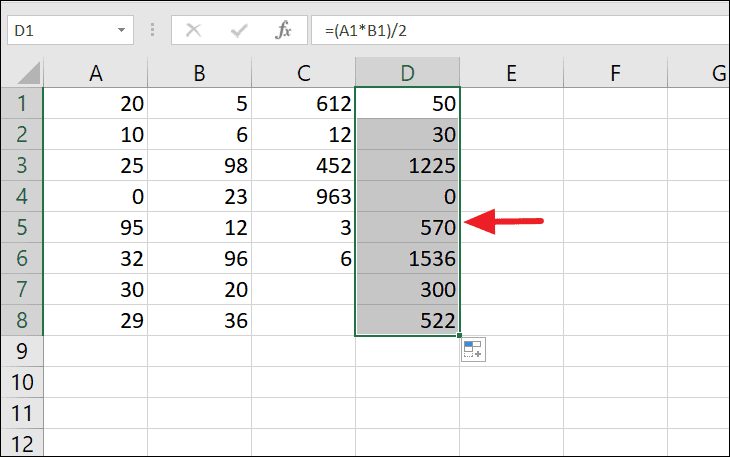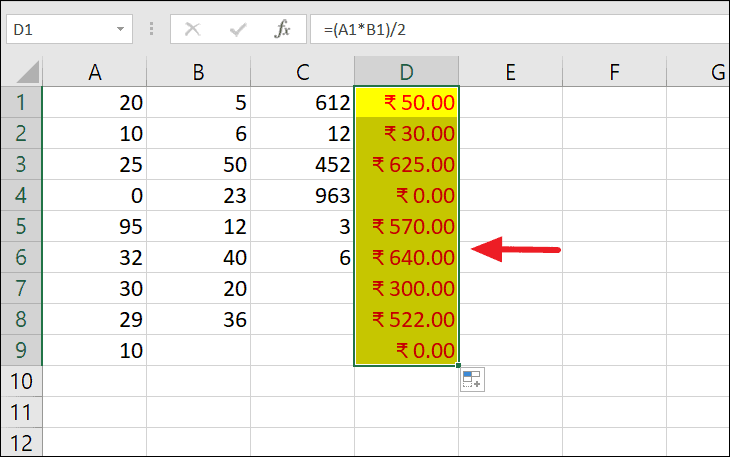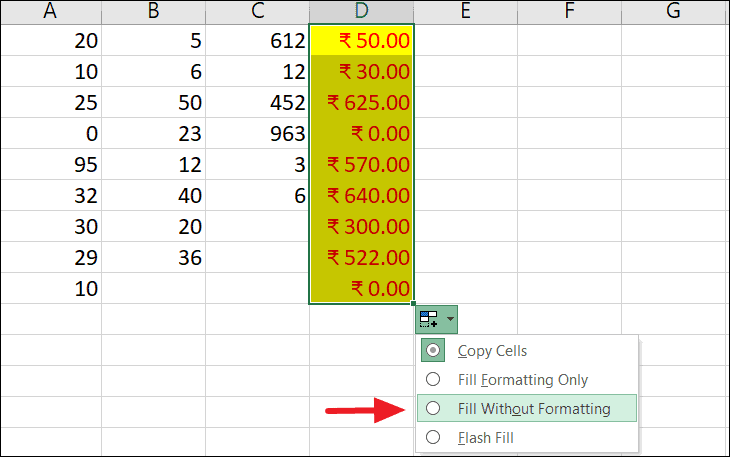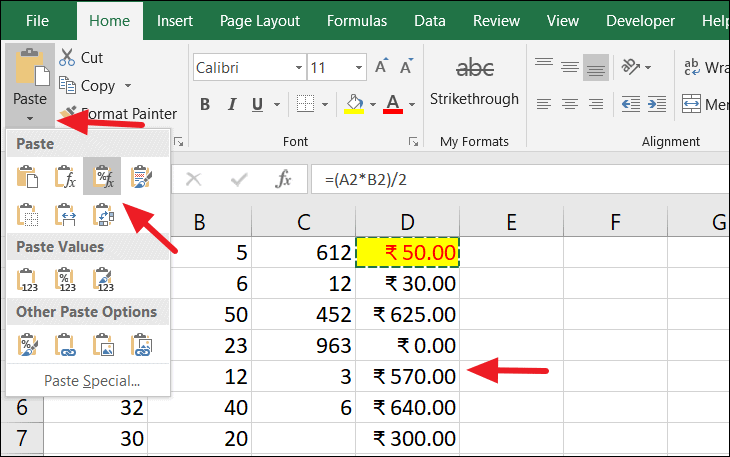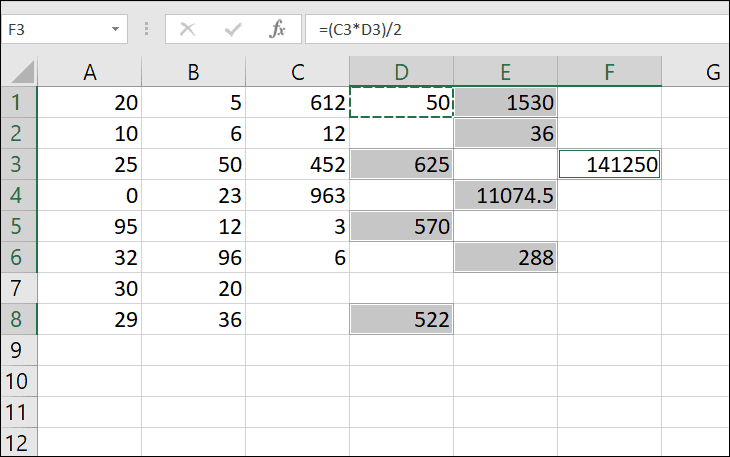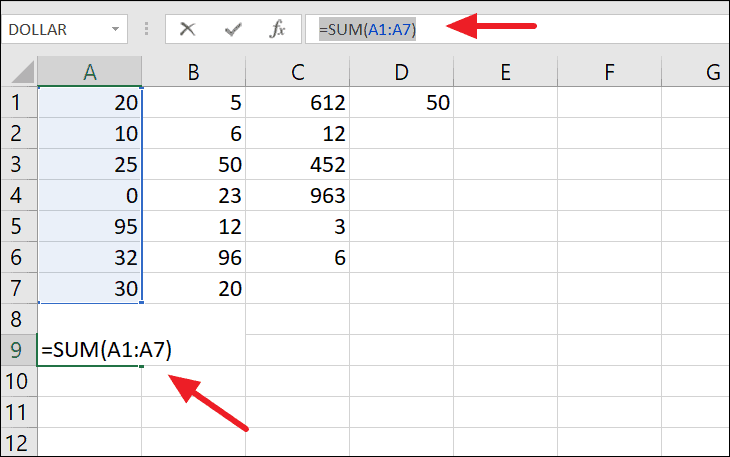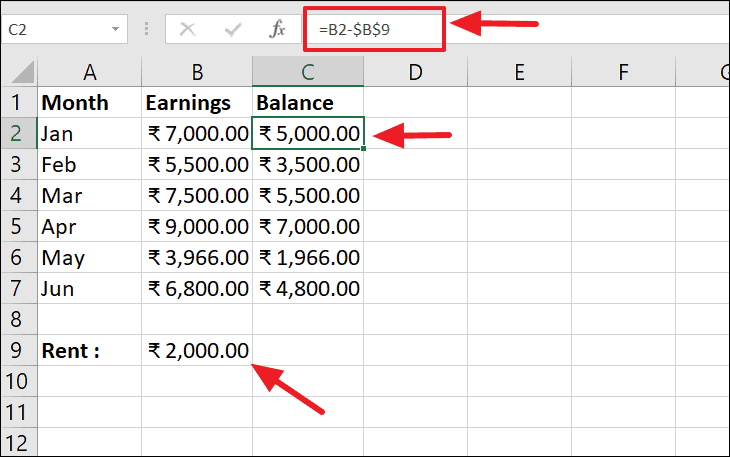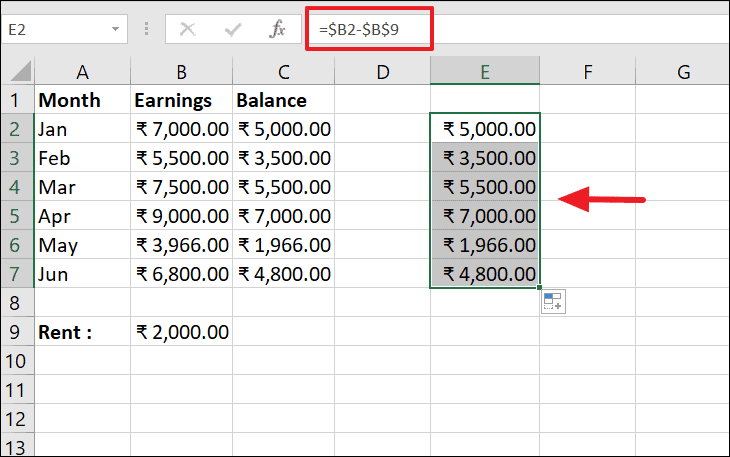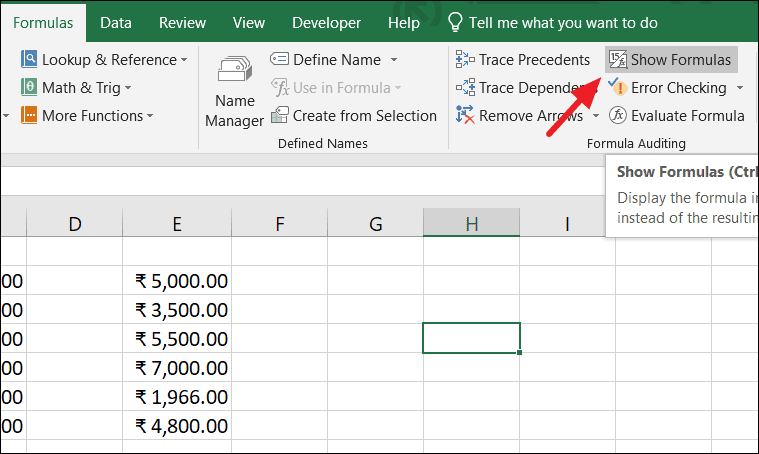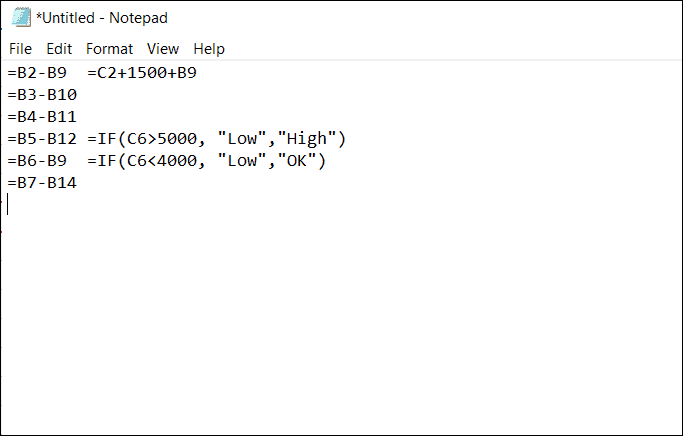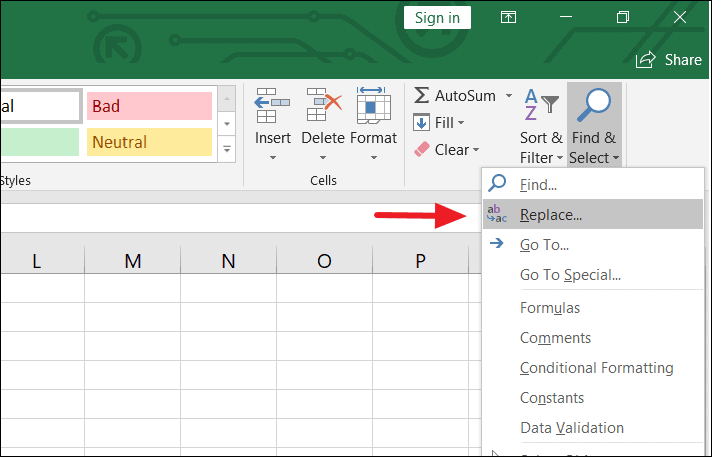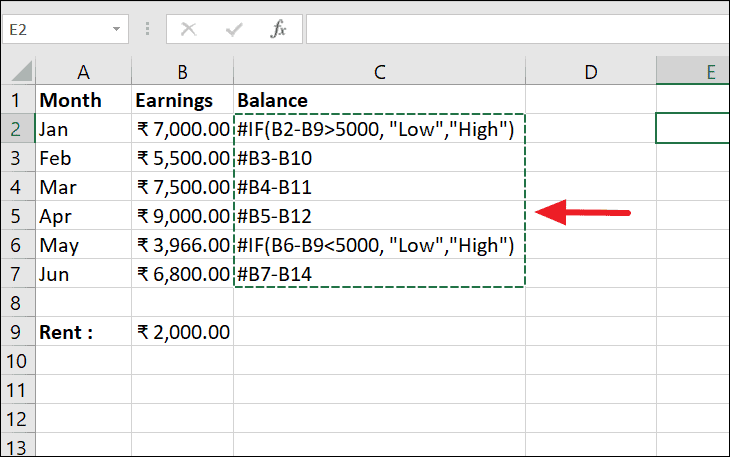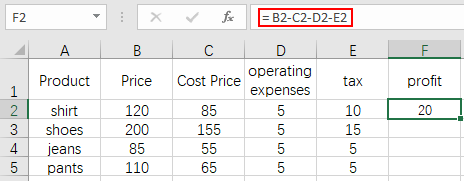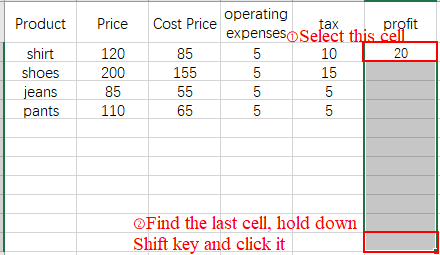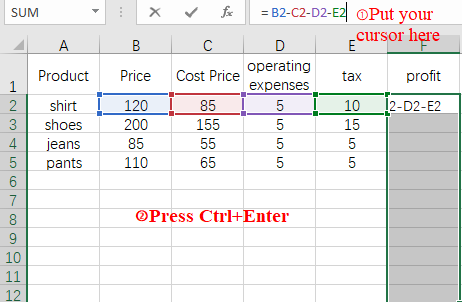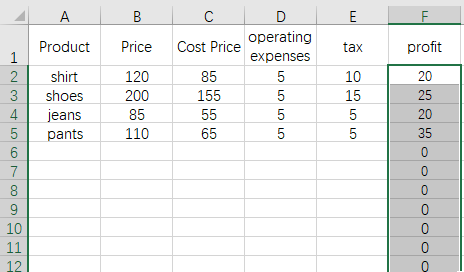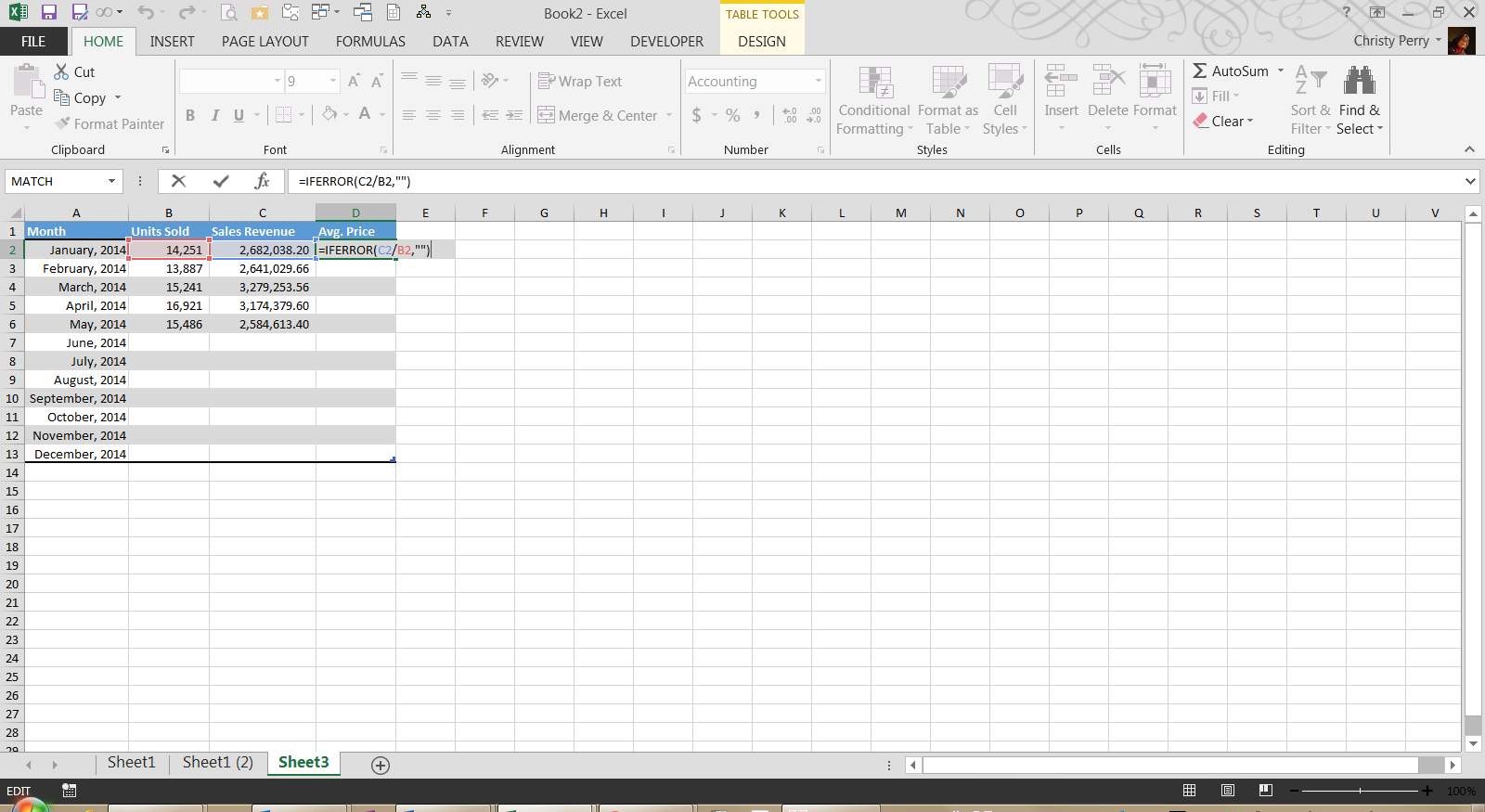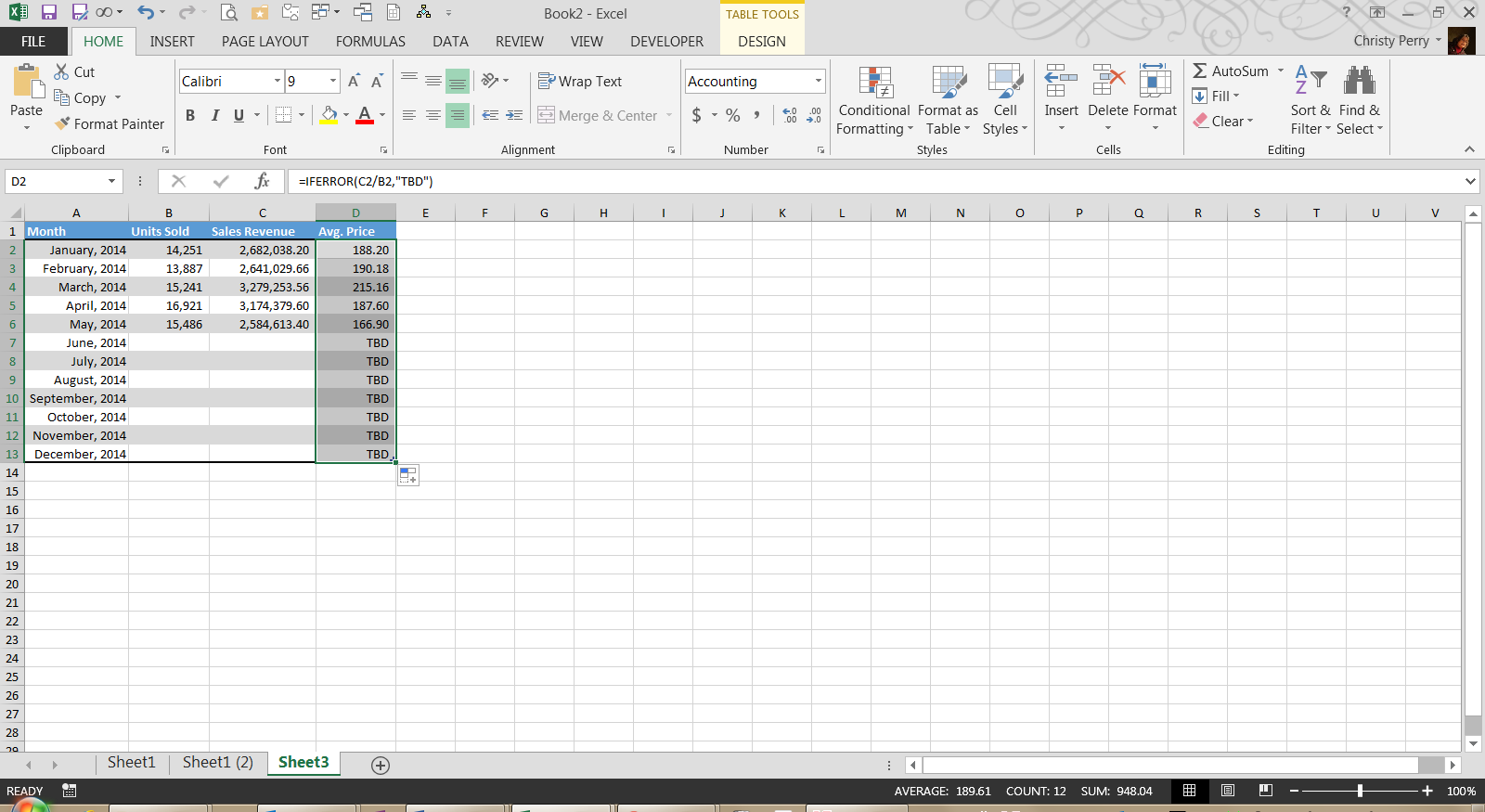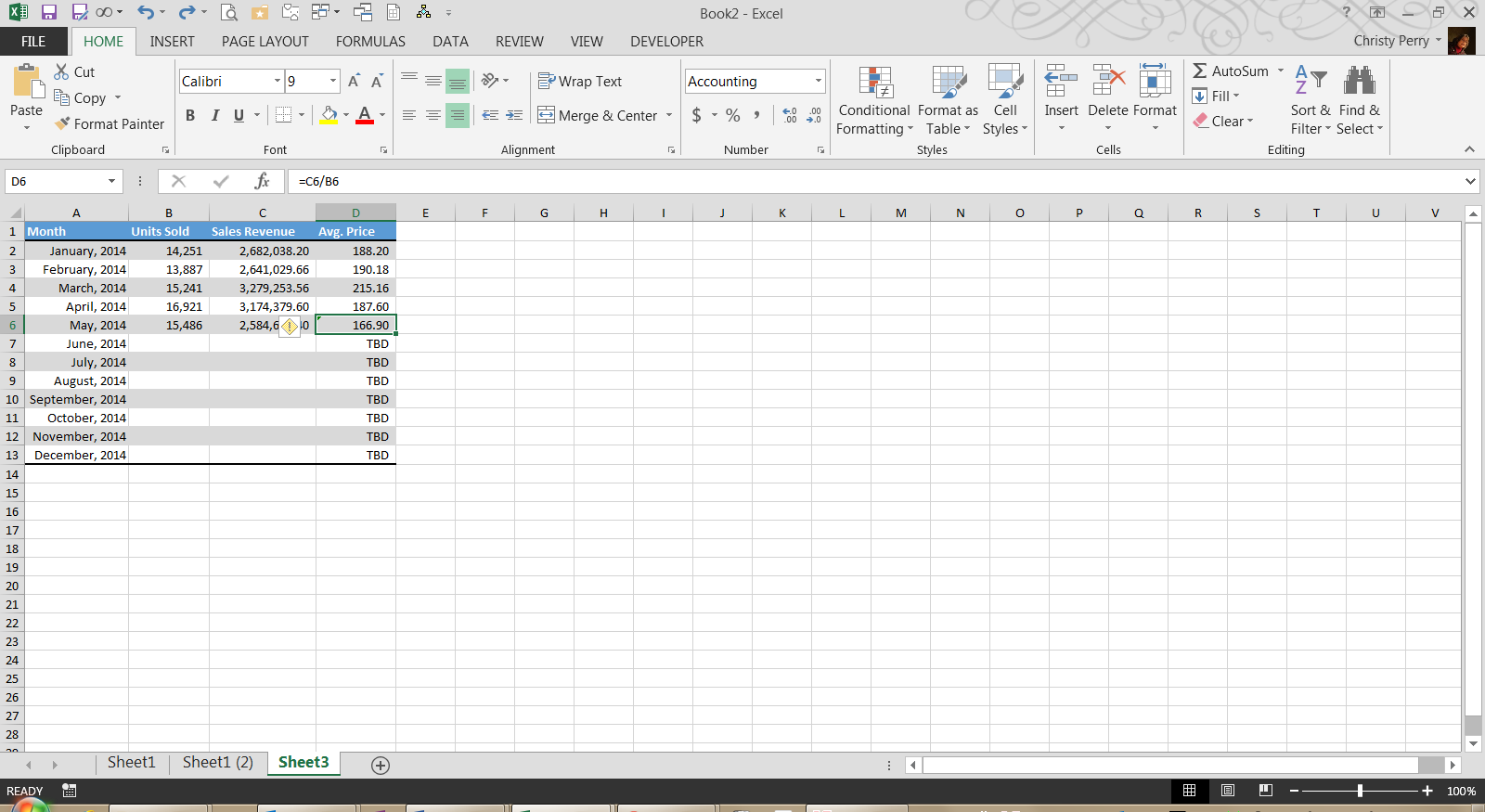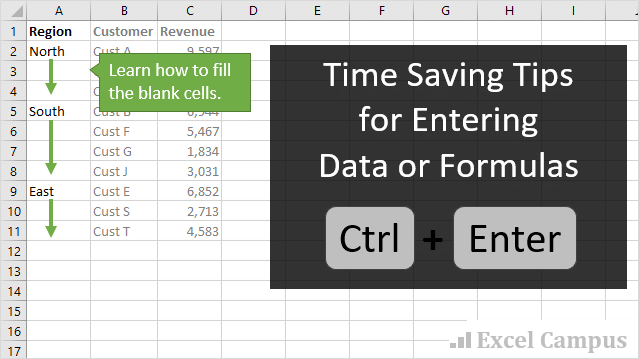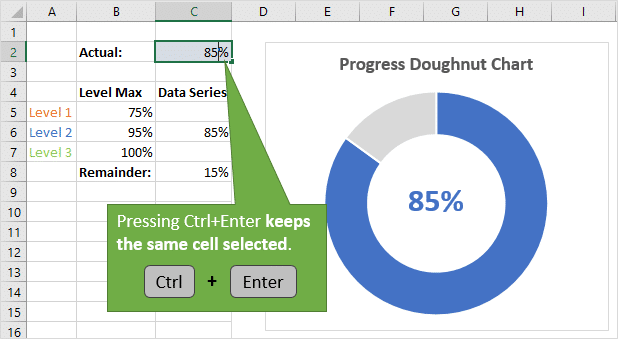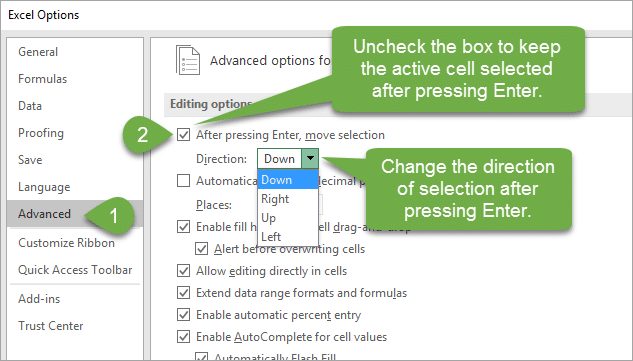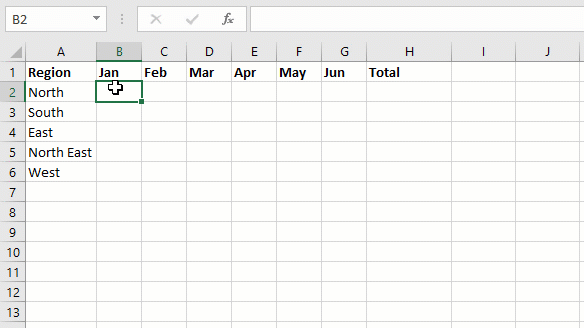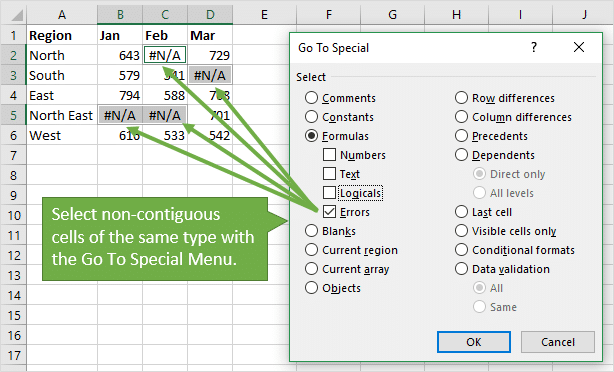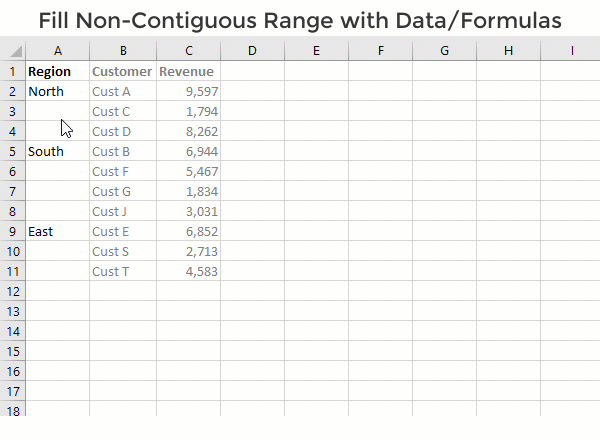It’s important to be aware of the possibilities for how a relative cell reference might change when you move or copy a formula.
-
Moving a formula: When you move a formula, the cell references within the formula do not change no matter what type of cell reference that you use.
-
Copying a formula: When you copy a formula, relative cell references will change.
Move a formula
-
Select the cell that contains the formula that you want to move.
-
In the Clipboard group of the Home tab, click Cut.
You can also move formulas by dragging the border of the selected cell to the upper-left cell of the paste area. This will replace any existing data.
-
Do one of the following:
-
To paste the formula and any formatting: In the Clipboard group of the Home tab, click Paste.
-
To paste the formula only: In the Clipboard group of the Home tab, click Paste, click Paste Special, and then click Formulas.
-
Copy a formula
-
Select the cell containing the formula that you want to copy.
-
In the Clipboard group of the Home tab, click Copy.
-
Do one of the following:
-
To paste the formula and any formatting, in the Clipboard group of the Home tab, click Paste.
-
To paste the formula only, iIn the Clipboard group of the Home tab, click Paste, click Paste Special, and then click Formulas.
Note: You can paste only the formula results. In the Clipboard group of the Home tab, click Paste, click Paste Special, and then click Values.
-
-
Verify that the cell references in the formula produce the result that you want. If necessary, switch the type of reference by doing the following:
-
-
Select the cell that contains the formula.
-
In the formula bar
, select the reference that you want to change.
-
Press F4 to switch between the combinations.
The table summarizes how a reference type will updates if a formula containing the reference is copied two cells down and two cells to the right.
-
|
For a formula being copied: |
If the reference is: |
It changes to: |
|---|---|---|
|
|
$A$1 (absolute column and absolute row) |
$A$1 |
|
A$1 (relative column and absolute row) |
C$1 |
|
|
$A1 (absolute column and relative row) |
$A3 |
|
|
A1 (relative column and relative row) |
C3 |
Note: You can also copy formulas into adjacent cells by using the fill handle 
Moving formulas is very much like moving data in cells. The one thing to watch for is that the cell references used in the formula are still what you want after you move.
-
Select the cell that contains the formula you want to move.
-
Click Home > Cut (or press Ctrl + X).
-
Select the cell you want the formula to be in, and then click Paste (or press Ctrl + V).
-
Verify that the cell references are still what you want.
Tip: You can also right-click the cells to cut and paste the formula.
Copying formulas is one of the most common and easiest tasks that you do in a typical spreadsheet that relies mainly on formulas. Rather than typing the same formula over and over again in Excel, you can just easily copy and paste a formula from one cell to multiple cells.
After writing a formula in Excel, you can use the copy and paste commands to multiple cells, multiple non-adjacent cells, or entire columns. If you don’t do it right, you’ll end up with that awful # REF and /DIV0 errors. In this article, we’ll show you the different methods you can use to copy formulas in Excel.
How to Copy and Paste Formulas in Excel
Microsoft Excel provides various ways to copy formulas with relative cell references, absolute cell references, or mixed references.
- Copy formula from one cell to another
- Copy formula one cell to multiple cells
- Copying formula to the entire column
- Copying formula without formatting
- Copy formulas to non-adjacent cells
- Copy formulas without changing cell references
How to Copy a Formula from One Cell to Another in Excel
Sometimes you may want to copy a formula from one cell to another in excel to avoid retyping the entire formula all over again and save some time while doing that.
Let’s say we have this table:
There are few methods to copy formula from one cell to another.
First, select the cell with the formula and right-click, and in the context menu, select ‘Copy’ to copy the formula. Or you can use the ‘Copy’ option in the ‘Clipboard’ section of the ‘Home’ tab.
But you also copy formulas by simply pressing the keyboard shortcut Ctrl + C. This is a more efficient and time-saving method.
Then we go to the cell we want to paste it press the shortcut Ctrl + V to paste the formula. Or right-click on the cell you want to paste and click the options under ‘Paste Options’: either simple ‘Paste (P)’ option or paste as ‘Formula (F)’ option.
Alternatively, you can also click on ‘Paste Special’ below the six paste icons to open the ‘Paste Special’ dialog box. Here, you have several options including the six paste options from the context menu. Select ‘All’ or ‘Formulas’ under the Paste section and click ‘OK’.
Now the cell with pasted formula should have the same formulas (as the one in copied cell) but with the different cell references. The cell address is self adjusted by the excel to match row number of the pasted cell.
Copy Formula from One Cell to Multiple Cells
The same paste operation works just the same if we select multiple cells or a range of cells.
Select the cell with the formula and press Ctrl + C to copy the formula. Then, select all the cells where you want to paste the formula and press Ctrl + V to paste the formula or use one of the above paste methods to paste the formula (like we did for the single cell).
Copy Formula to an Entire Column or Row
In Excel, you can quickly copy a formula to an entire column or a row.
To copy a formula to a column or a row, first, enter a formula in a cell. Then, select the formula cell (D1), and hover your cursor over a small green square at the lower right corner of the cell. As you hover, the cursor will change to a black plus sign (+), which is called the Fill Handle. Click and hold that fill handle, and drag it in any direction you want (column or row) over the cells to copy the formula.
When you copy a formula to a range of cells, cell references of the formula will automatically adjust based on the relative location of rows and columns and the formula will perform calculations based on the values in those cell references (See below).
In the above example, when formula in D1 (=A1*B1)/2) copied to cell D2, the relative reference changes bases on it’s location (=A2*B2)/2) and so on.
In the same way, you can drag the formula into adjacent cells to the left, to the right, or upwards.
Another way to copy the formula to an entire column is by double-clicking the fill handle instead of dragging it. When you double-click the fill handle, it immediately applies the formula as far as there is any data to the adjacent cell.
Copy a Formula to a Range Without Copying Formatting
When you copy a formula to a range of cells with the fill handle, it copies the source cell’s formatting too, such as font color or background color, currency, percentage, time, etc (as shown below).
To prevent copying the cell formatting, drag the fill handle and click the ‘Auto Fill Options’ at the lower right-hand corner of the last cell. Then, in the drop-down menu, select ‘Fill Without Formatting’.
The result:
Copy an Excel Formula with Only Number Formatting
If you want to copy the formula with only the formula and the formatting such as percentage format, decimal points, etc.
Copy the formula and select all the cells to which you want to copy the formula. On the ‘Home’ tab, click the arrow below the ‘Paste’ button on the ribbon. Then, click the ‘Formulas & Number Formatting’ icon (the icon with % fx) from the drop-down to paste only the formula and the number formatting.
This option only copies formula and number formatting but ignores all other cell formattings like background color, font color, etc.
Copy a Formula to Non-Adjacent/Non-Contiguous Cells
If you want to copy a formula to non-adjacent cells or non-adjacent ranges, you can do that with the help of Ctrl key.
Select the cell with the formula and press Ctrl + C to copy it. Then, select non-adjacent cells/ranges while pressing and holding the Ctrl key. Then, press Ctrl + V to paste the formula and hit Enter to complete.
Copying Formulas Without Changing Cell References in Excel
When a formula is copied to another cell, Excel automatically changes the cell references to match its new location. These cell references use the relative location of a cell address, hence they are called relative cell reference (without $). For example, if you have the formula ‘=A1*B1’ in cell C1, and you copy this formula to cell C2, the formula will change to ‘=A2*B2’. All the methods we discussed above use relative references.
When you copy a formula with relative cell references, it automatically changes references so that the formula refers to the corresponding rows and columns. If you use absolute references in a formula, then the same formula gets copied without changing the cell references.
When you put a dollar sign ($) in front of the column letter and row number of a cell (For example $A$1), it turns the cell into an absolute cell. Now no matter where you copy the formula that contains the absolute cell reference, the formula will never. But if you have relative or mixed cell reference in a formula, use any of these following methods to copy without changing cell references.
Copy Formula with Absolute Cell Reference Using Copy-Paste Method
Occasionally, you may need to copy/apply the exact formula down the column, without changing the cell references. If you want to copy or move an exact formula with absolute reference, then do this:
First, select the cell with the formula you want to copy. Then, click on the formula bar, select the formula using the mouse, and press Ctrl + C to copy it. If you want to move the formula, press Ctrl + X to cut it. Next, hit the Esc key to leave the formula bar.
Alternatively, select the cell with the formula and hit F2 key or double-click the cell. This will put the selected cell into edit mode. Then, select the formula in the cell and hit Ctrl + C to copy the formula in the cell as text.
Then, select the destination cell and press Ctrl + V to paste the formula.
Now the exact formula gets copied into the destination cell without any cell reference changes.
Copy Formulas with Absolute or Mixed Cell References
If you’d like to move or copy exact formulas without changing cell references, you should change cell relative references to absolute references. For example, adding ($) sign to relative cell reference (B1) makes it an absolute reference ($B$1), so it remains static no matter where the formula is copied or moved.
But sometimes, you may need to use mixed cell references ($B1 or B$1) by adding a dollar ($) sign in front of the column letter or the row number to lock either a row or a column in place.
Let us explain with an example. Suppose you have this table that calculates the monthly savings by subtracting rent (B9) from earnings (in column B) every month.
In the example below, the formula uses an absolute cell reference ($B$9) to lock the rent amount to cell B9, and a relative cell reference to cell B2 because it needs to be adjusted for each row to match each month. B9 is made absolute cell reference ($B$9) because you want to subtract the same rent amount from each month’s earnings.
Let’s say you want to move the balances from column C to column E. If you copy the formula (by usual copy/paste method) from cell C2 (=B2-$B$9) will change to =D2-$B$9 when pasted in cell E2, making your calculations all wrong!
In that case, change the relative cell reference (B2) to a mixed cell reference ($B2) by adding the ‘$’ sign in front of the column letter of the formula entered in the cell C2.
And now, if you copy or move the formula from cell C2 to E2, or any other cell, and apply formula down the column, the column reference will remain the same while the row number will be adjusted for each cell.
Copy Paste Excel Formulas Without Changing References Using Notepad
You can see every formula in your Excel spreadsheet by using Show Formula options. To do that go to the ‘Formulas’ tab and select ‘Show Formulas’.
Alternatively, you can enter the formula view mode by pressing the Ctrl + ` shortcut, which displays every formula in your worksheet. You can find the grave accent key (`) at the top left corner of your keyboard on the row with the number keys (below the ESC key and before the number 1 key).
Select all the cells with the formulas you want to copy and press Ctrl + C to copy them, or Ctrl + X to cut them. Then open Notepad and press Ctrl + V to paste the formulas in the notepad.
Next, select the formula and copy(Ctrl + C) it from the notepad, and paste it(Ctrl + V) in the cell where you want the exact formula copied. You can copy and paste them one by one or all at once.
After pasting the formulas, turn off the formula view mode by pressing Ctrl + ` or again go to ‘Formulas’ –> ‘Show formulas’.
Copy the Exact Formulas Using Excel’s Find and Replace
If you want to copy a range of Exact formulas, you can also use Excel’s Find and Replace tool to do so.
Select all the cells that have the formulas that you want to copy. Then go to the ‘Home’ tab, click ‘Find & Select’ on the Editing group, and select the ‘Replace’ option, Or simply press Ctrl + H to open the Find & Replace dialog box.
In the Find and Replace dialog box, enter the equal sign (=) in the ‘Find what’ field. In the ‘Replace with’ field, enter a symbol or character that is not already part of your formulas, like #, or , etc. Then, click the ‘Replace All’ button.
You’ll get a prompt message box saying ‘We made 6 replacements’ (because we selected 6 cells with formulas). Then click ‘OK’ and ‘Close’ to close both dialogs. Doing this replaces all equal to (=) signs with hash (#) signs, and turns formulas into text strings. Now the cell references of the formulas won’t be changed when copied.
Now, you can select these cells, press Ctrl + C to copy them, and paste them into destination cells with Ctrl + V.
Finally, you need to change the (#) signs back to (=) signs. To do that, select both ranges (original and copied range) and press Ctrl + H to open the Find & Replace dialog box. This time, type the hash (#) sign in the ‘Find what’ field, and equal to (=) sign in the ‘Replace with’ field, and click the ‘Replace All’ button. Click ‘Close’ to close the dialog.
Now, the text strings are converted back to the formulas and you will get this result:
Done!
Download Article
Download Article
- Using Find and Replace
- Filling a Column or Row
- Pasting a Formula into Multiple Cells
- Using Relative and Absolute Cell References
- Video
- Q&A
- Tips
- Warnings
|
|
|
|
|
|
|
Excel makes it easy to copy your formula across an entire row or column, but you don’t always get the results you want. If you end up with unexpected results, or those awful #REF and /DIV0 errors, it can be extremely frustrating. But don’t worry—you won’t need to edit your 5,000 line spreadsheet cell-by-cell. This wikiHow teaches you easy ways to copy formulas to other cells.
-
1
Open your workbook in Excel. Sometimes, you have a large spreadsheet full of formulas, and you want to copy them exactly. Changing everything to absolute cell references would be tedious, especially if you just want to change them back again afterward. Use this method to quickly move formulas with relative cell references elsewhere without changing the references.[1]
In our example spreadsheet, we want to copy the formulas from column C to column D without changing anything.Example Spreadsheet
Column A Column B Column C Column D row 1 944
Frogs
=A1/2
row 2 636
Toads
=A2/2
row 3 712
Newts
=A3/2
row 4 690
Snakes
=A4/2
- If you’re just trying to copy the formula in a single cell, skip to the last step («Try alternate methods») in this section.
-
2
Press Ctrl+H to open the Find window. The shortcut is the same on Windows and macOS.
Advertisement
-
3
Find and replace «=» with another character. Type «=» into the «Find what» field, and then type a different character into the «Replace with» box. Click Replace All to turn all formulas (which always begin with an equal’s sign) into text strings beginning with some other character. Always use a character that you have not used in your spreadsheet. For example, replace it with # or &, or a longer string of characters, such as ##&.
Example Spreadsheet
Column A Column B Column C Column D row 1 944
Frogs
##&A1/2
row 2 636
Toads
##&A2/2
row 3 712
Newts
##&A3/2
row 4 690
Snakes
##&A4/2
- Do not use the characters * or ?, since these will make later steps more difficult.
-
4
Copy and paste the cells. Highlight the cells you want to copy, and then press Ctrl + C (PC) or Cmd + C (Mac) to copy them. Then, select the cells you want to paste into, and press Ctrl + V (PC) or Cmd + V (Mac) to paste. Since they are no longer interpreted as formulas, they will be copied exactly.
Example Spreadsheet
Column A Column B Column C Column D row 1 944
Frogs
##&A1/2
##&A1/2
row 2 636
Toads
##&A2/2
##&A2/2
row 3 712
Newts
##&A3/2
##&A3/2
row 4 690
Snakes
##&A4/2
##&A4/2
-
5
Use Find & Replace again to reverse the change. Now that you have the formulas where you want them, use «Replace All» again to reverse your change. In our example, we’ll look for the character string «##&» and replace it with «=» again, so those cells become formulas once again. You can now continue editing your spreadsheet as usual:
Example Spreadsheet
Column A Column B Column C Column D row 1 944
Frogs
=A1/2
=A1/2
row 2 636
Toads
=A2/2
=A2/2
row 3 712
Newts
=A3/2
=A3/2
row 4 690
Snakes
=A4/2
=A4/2
-
6
Try alternate methods. If the method described above doesn’t work for some reason, or if you are worried about accidentally changing other cell contents with the «Replace all» option, there are a couple other things you can try:
- To copy a single cell’s formula without changing references, select the cell, then copy the formula shown in the formula bar near the top of the window (not in the cell itself). Press Esc to close the formula bar, then paste the formula wherever you need it.
- Press Ctrl and ` (usually on the same key as ~) to put the spreadsheet in formula view mode. Copy the formulas and paste them into a text editor such as Notepad or TextEdit. Copy them again, then paste them back into the spreadsheet at the desired location. Then, press Ctrl and ` again to switch back to regular viewing mode.
Advertisement
-
1
Type a formula into a blank cell. Excel makes it easy to propagate a formula down a column or across a row by «filling» the cells. As with any formula, start with an = sign, then use whichever functions or arithmetic you’d like. We’ll use a simple example spreadsheet, and add column A and column B together. Press Enter or Return to calculate the formula.
Example Spreadsheet
Column A Column B Column C row 1 10
9
19
row 2 20
8
row 3 30
7
row 4 40
6
-
2
Click the lower right corner of the cell with the formula you want to copy. The cursor will become a bold + sign.
-
3
Click and drag the cursor across the column or row you’re copying to. The formula you entered will automatically be entered into the cells you’ve highlighted. Relative cell references will automatically update to refer to the cell in the same relative position rather than stay exactly the same. Here’s our example spreadsheet, showing the formulas used and the results displayed:
Example Spreadsheet
Column A Column B Column C row 1 10
9
=A1+B1
row 2 20
8
=A2+B2
row 3 30
7
=A3+B3
row 4 40
6
=A4+B4
Example Spreadsheet
Column A Column B Column C row 1 10
9
19
row 2 20
8
28
row 3 30
7
37
row 4 40
6
46
- You can also double-click the plus sign to fill the entire column instead of dragging. Excel will stop filling out the column if it sees an empty cell. If the reference data contains a gap, you will have to repeat this step to fill out the column below the gap.
- Another way to fill the entire column with the same formula is to select the cells directly below the one containing the formula and then press Ctrl + D.[2]
Advertisement
-
1
Type the formula into one cell. As with any formula, start with an = sign, then use whichever functions or arithmetic you’d like. We’ll use a simple example spreadsheet, and add column A and column B together. When you press Enter or Return, the formula will calculate.
Example Spreadsheet
Column A Column B Column C row 1 10
9
19
row 2 20
8
row 3 30
7
row 4 40
6
-
2
Select the cell and press Ctrl+C (PC) or ⌘ Command+C (Mac). This copies the formula to your clipboard.
-
3
Select the cells you want to copy the formula to. Click on one and drag up or down using your mouse or the arrow keys. Unlike with the column or row fill method, the cells you are copying the formula to do not need to be adjacent to the cell you are copying from. You can hold down the Control key while selecting to copy non-adjacent cells and ranges.
-
4
Press Ctrl+V (PC) or ⌘ Command+V (Mac) to paste. The formulas now appear in the selected cells.
Advertisement
-
1
Use a relative cell reference in a formula. In an Excel formula, a «cell reference» is the address a cell. You can type these in manually, or click on the cell you wish to use while you are entering a formula. For example, the following spreadsheet has a formula that references cell A2:
Relative References
Column A Column B Column C row 2 50
7
=A2*2
row 3 100
row 4 200
row 5 400
-
2
Understand why they’re called relative references. In an Excel formula, a relative reference uses the relative position of a cell address. In our example, C2 has the formula “=A2”, which is a relative reference to the value two cells to the left. If you copy the formula into C4, then it will still refer to two cells to the left, now showing “=A4”.
Relative References
Column A Column B Column C row 2 50
7
=A2*2
row 3 100
row 4 200
=A4*2
row 5 400
- This works for cells outside of the same row and column as well. If you copied the same formula from cell C1 into cell D6 (not shown), Excel would change the reference «A2» to a cell one column to the right (C→D) and 5 rows below (2→7), or «B7».
-
3
Use an absolute reference instead. Let’s say you don’t want Excel to automatically change your formula. Instead of using a relative cell reference, you can make it absolute by adding a $ symbol in front of the column or row that you want to keep the same, no matter where you copy the formula too.[3]
Here are a few example spreadsheets, showing the original formula in larger, bold text, and the result when you copy-paste it to other cells:-
Relative Column, Absolute Row (B$3): The formula has an absolute reference to row 3, so it always refers to row 3:
Column A Column B Column C row 1 50
7
=B$3
row 2 100
=A$3
=B$3
row 3 200
=A$3
=B$3
row 4 400
=A$3
=B$3
-
Absolute Column, Relative Row ($B1): The formula has an absolute reference to column B, so it always refers to column B.
Column A Column B Column C row 1 50
7
=$B1
row 2 100
=$B2
=$B2
row 3 200
=$B3
=$B3
row 4 400
=$B4
=$B4
-
Absolute Column & Row ($B$1): The formula has an absolute reference to column B of row 1, so it always refers to column B of row 1.
Column A Column B Column C row 1 50
7
=$B$1
row 2 100
=$B$1
=$B$1
row 3 200
=$B$1
=$B$1
row 4 400
=$B$1
=$B$1
-
Relative Column, Absolute Row (B$3): The formula has an absolute reference to row 3, so it always refers to row 3:
-
4
Use the F4 key to switch between absolute and relative. Highlight a cell reference in a formula by clicking it and press F4 to automatically add or remove $ symbols. Keep pressing F4 until the absolute or relative references you’d like are selected, then press Enter or Return.
Advertisement
Add New Question
-
Question
When I try to pull down formula, it stays the same and does not change with row, what can I do?
Go to Formulas, Calculation Options, and change them from Manual to Automatic.
-
Question
When I click and drag, it copies the format also. I don’t want to copy the format, just the formula?
Krisztian Toth
Community Answer
Right after the drag there should be an icon in the lower right corner of the highlighted area. Hover over that and select from the various fill options, among which you can find an option to fill without format.
-
Question
How do I copy a date formula I have created (that includes the week day as well as date) so that it runs in sequence?
Krisztian Toth
Community Answer
Double click into the cell, copy your formula, double click into the destination cell, then press Ctrl+V or Command+V.
Ask a Question
200 characters left
Include your email address to get a message when this question is answered.
Submit
Advertisement
-
If you copy a formula to a new cell and see a green triangle, Excel has detected a possible error. Examine the formula carefully to see if anything went wrong.[4]
-
If you accidentally did replace the = character with ? or * in the «copying a formula exactly» method, searching for «?» or «*» will not give you the results you expect. Correct this by searching for «~?» or for «~*» instead.[5]
-
Select a cell and press Ctrl‘ (apostrophe) to fill it with the formula directly above it.
Thanks for submitting a tip for review!
Advertisement
-
Different versions of Excel may not show exactly the same screenshots in the same ways as are displayed here.
Advertisement
References
About This Article
Article SummaryX
To copy a formula into multiple adjoining cells in Microsoft Excel, type the formula into a cell, and then press Enter or Return to calculate it. Hover your mouse cursor over the bottom-right corner of the cell so the cursor turns to a crosshair, then drag the crosshair down to copy the formula to other cells in the column. If you’d rather copy the formula to cells in a row, drag the crosshair left or right.
To copy a formula to cells that aren’t touching the formula cell, click the cell once to select it, and then press Control + C (on a PC) or Command + C (on a Mac) to copy the formula. Now, select the cell or cells you want to copy the formula to, then press Control + V (on a PC) or Command + V (on a Mac) to paste it into the selected cells.
Did this summary help you?
Thanks to all authors for creating a page that has been read 513,635 times.
Is this article up to date?
-
— By
Sumit Bansal
Watch Video – Copy and Paste Formulas in Excel without Changing Cell References
When you copy and paste formulas in Excel, it automatically adjusts the cell references.
For example, suppose I have the formula =A1+A2 in cell B1. When I copy the cell B1 and paste it in B2, the formula automatically becomes =A2+A3.
This happens as Excel automatically adjusts the references to make sure the rows and columns now refer to the adjusted rows and columns.
Note: This adjustment happens when you’re using relative references or mixed references. In the case of absolute references, the exact formula gets copied.
Copy and Paste Formulas in Excel without Changing Cell References
When using relative/mixed references in your formulas, you may – sometimes – want to copy and paste formulas in Excel without changing the cell references.
Simply put, you want to copy the exact formula from one set of cells to another.
In this tutorial, I will show you how you can do this using various ways:
- Manually Copy Pasting formulas.
- Using ‘Find and Replace’ technique.
- Using the Notepad.
Manually Copy Paste the Exact Formula
If you only have a handful of formulas that you want to copy and paste without changing the cell references, doing it manually would be more efficient.
To copy paste formulas manually:
- Select the cell from which you want to copy the formula.
- Go to the formula bar and copy the formula (or press F2 to get into the edit mode and then copy the formula).
- Select the destination cell and paste the formula.
Note that this method works only when you have a few cells from which you want to copy formulas.
If you have a lot, use the find and replace technique shown below.
Using Find and Replace
Here are the steps to copy formulas without changing the cell references:
This will convert the text back into the formula and you will get the result.
Note: If you use the # character as a part of your formula, you can use any other character in Replace with (such as ‘ZZZ’ or ‘ABC’).
Using Notepad to Copy Paste Formulas
If you have a range of cells where you have the formulas that you want to copy, you can use a Notepad to quickly copy and paste the formulas.
Here are the steps to copy formulas without changing the cell references:
- Go to Formulas –> Show Formulas. This will show all the formulas in the worksheet.
- Copy the cells that have the formulas that you want to copy.
- Open a notepad and paste the cell contents in the notepad.
- Copy the content on the notepad and paste in the cells where you want the exact formulas copied.
- Again go to Formulas –> Show formulas.
Note: Instead of Formulas –> Show formulas, you can also use the keyboard shortcut Control + ` (this is the same key that has the tilde sign).
You May Also Like the Following Tutorials:
- How to Convert Formulas to Values in Excel.
- Show Formulas in Excel Instead of the Values.
- How to Lock Formulas in Excel.
- Understanding Absolute, Relative, and Mixed Cell References in Excel.
- How to reference another sheet in Excel.
- How to Remove Cell Formatting in Excel
- How to Copy Excel Table to Word
- How to Copy and Paste Column in Excel?
- How to Multiply a Column by a Number in Excel
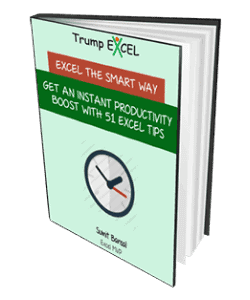
Get 51 Excel Tips Ebook to skyrocket your productivity and get work done faster
31 thoughts on “How to Copy and Paste Formulas in Excel without Changing Cell References”
-
Thank you for your help.
“Using Find and Replace” is very good option. it really works. -
Thank you very much
-
BROOOOOO! This was so smart and easy. Thanks my friend!
-
Excellent. That has made my work today so much easier!!
-
Thanks you so much! This Helped me a lot!!
-
Great! Thanks for the teaching! Loving the Notepad method
-
Amazing….such a nice n easy way to do it with replace..thanks a lot
-
Thanks alot. really helpful
-
Nice. Very well explained, thank you.
-
OH. MY. GOSH. I’m 10 hours of copying and pasting formulas but this has saved me at least a few more and countless future hours! Replacing = with #, pasting, then replacing # with =. It’s so simple… why didn’t I think of it. 🙂 Thank you!
-
Thanks a lot Simple & Eazy
-
# is best and easiest solution, thanks a lot!!! very clever!
-
thanks a lot
-
This saved me tonnes of work. Thanks so much!
-
For a copying and pasting a large array of formulas comprising both relative and absolute references to different cells, sheets and workbooks, the ‘find and replace’ has proven to be convoluted, time consuming and problematic. One has to ‘cherry pick’ through the array to ensure which of one’s relative cell references are not to be changed.
I migrated to excel from lotus-123; as a comparison using ‘123’ back then, one would simply ‘highlight rows (or columns)’, ‘copy’, ‘insert’ equal rows (or columns), then ‘paste’ – quick and most importantly no cherry picking errors.
Excel’s ‘insert copied cells’ command hides the ‘insert row or column’ command, therefore one cannot emulate the ‘123’ way. Even if one tries the ‘insert sheet rows (or columns)’ command then attempt to paste directly from ‘clipboard’, only text and not formulas are pasted. -
amazing!
thanks
saved me 20 min. of work… -
THIS IS AWESOME! – THE # = TRICK. GENIUS!
THANK U VERY MUCH!-
Agree! This is so simple, but very helpful. Thanks!
-
-
I have a cell reference issue I hope someone can help me with. I have a cell outside of a range that I always want to refer to a specific cell inside of the range, even when cells are inserted or deleted from the range. For example, cell A10 refers to C10 in the range B1:D200. If someone inserts cells B7:D13, I still want A10 to refer to C10, not C17. I think I need a helper column that has the text “C10” in cell E10. What is the Function that gets A10 to use the static text in E10 to refer to cell C10?
-
You can use the INDIRECT function. This should work =INDIRECT(“C10”). If you have text C10 in cell E10, just use =INDIRECT(E10)
-
Thanks. That is the Function I was looking for, but could not remember.
-
Even though INDIRECT is less complicated, can you tell me why CELL(“contents”,ADDRESS(10,3)) didn’t work?
-
Jim,
although these are functions I’ve never had cause to use, I think this might be because the $C$10 from the ADDRESS function is seen as text, not a cell reference
CELL(“contents”,”$C$10″) certainly does not work
regards,
t’other jim
-
-
although INDIRECT is the way to go with this, you could also use OFFSET:
=OFFSET(A10,,2) should work
both are volatile formulae (will recalculate on every worksheet change), which you might be able to avoid by using =INDEX(C:C,10) which would only fail your requirements if a whole column were inserted or deleted somewhere between A:A and C:C-
taking this a step further, =INDEX(1:1048576,10,3) will always refer to C10 – but it’s very clumsy-looking
-
-
-
I’ve made a step in the right direction. ADDRESS(10,3) results in $C$10 and it does not change when cell C10 is moved. CELL(“contents”,$C$10) gives me the proper result. However, CELL(“contents”,ADDRESS(10,3)) is not even accepted. What is wrong with the nested formula?
-
you should use “=CELL(“contents”, INDIRECT(ADDRESS(10,3,1,1,”Sheet1″),1))” as there are certain arguments to ADDRESS function which ADDRESS(10,3) is not capturing and those arguments are not optional.
-
-
-
I think Bansal’s point was that sometimes you can have a range of dynamic formulae that you want to replicate elsewhere
I’ve had this situation occur before but I never thought of using the Notepad method – thanks for that, another weapon in my arsenal -
Absolute cell reference is the best. i.e. =A$1$ + B$1$ this cell is locked in that way.
-
I use absolute/Dynamic references for doing this
-
I love method 3. Thanks you.
-
Comments are closed.
If you have tons of data to deal with in a spreadsheet, it’s much more convenient to use Excel functions instead of manual calculations. But inputting formulas in each cell can also take a lot of time. Is there a way to enter it just once and apply the formula to multiple cells within seconds?
Take this table below as an example. I use a formula in it to calculate the profit of products. If I want to copy it in F3 manually, I must adjust it a little bit since the cells involved are different. This process will doubtlessly take a lot of time.
To copy this formula to multiple cells at once, the simplest way is using Fill Handle:
1. Putting your cursor at the right-lower corner of the cell F2 till it becomes a small black cross.
2. drag it down to contain all the cells you want to fill the formula in.
3. Release the mouse, you can see the formula has been applied to all these cells.
This method is quick and simple, but there’s still a little problem. If you have a rather long table to deal with, drag the cursor down to select the entire column may also be annoying.
For this situation, I’d like to share another tip:
1. Click F2 to select it, then scroll down to find the last cell in the column.
2. Hold down Shift key and click it.
3. Then put your cursor at the formula bar, press Ctrl+Enter to fill the formula in selected area.
4. Now you can check the result.
This method of copying formulas is more suitable for large tables with lots of data.
Copyright Statement: Regarding all of the posts by this website, any copy or use shall get the written permission or authorization from Myofficetricks.
Maintenance Alert: Saturday, April 15th, 7:00pm-9:00pm CT. During this time, the shopping cart and information requests will be unavailable.
Categories: Excel®
One of the more tedious tasks in Excel is to copy a formula down an entire column of a report. Not only is it mind-numbing, but it also leaves the opportunity for error if you don’t copy the formula down to exactly the correct cells. For best results, try one of the methods below.
Option 1: Drag the Plus
First create your formula in one cell.
After you are satisfied that it is correct, place your mouse cursor at the lower right-hand corner of the cell. You’ll know you have hit it when the cursor changes to a plus sign. Click the plus and drag it down, filling the cells with a copy of the original formula.
Option 2: Double-click the plus
What if you want to copy the formula down a four-hundred-line report? Option 1, dragging the plus down four hundred rows, would burn up your time—and your temper.
Instead, you can accomplish the same copy with a double-click instead of a drag. Set up your formula in the top cell, position the mouse in the lower right-hand corner of the cell until you see the plus, and double-click.
Note that this option can copy the formula down as far as Excel finds data to the left. If you have row headers or other data in place, Excel continues to copy the formula. The fill stops when Excel sees that you have no headers or data to the left.
Option 3: Copy and Paste
What if you want to copy the formula but not the formatting? What if you want to copy beyond the end of the data? Or if you have some other need for flexibility in copying the formula?
You can always use the good ole’ copy and paste method.
- Set up your formula in the top cell.
- Either press Control + C or click the “Copy” button on the “Home” ribbon.
- Select all the cells to which you wish to copy the formula. You can select cells either by dragging the mouse or by using keyboard shortcuts.
- Either press Control + V or click the “Paste” button on the “Home” ribbon. For more paste options, click the arrow below the “Paste” button.
Watch for Green Warning Triangles
What should you do if, after copying your formulas, you see a green triangle in the upper left-hand corner of a cell?
This indicates a possible error in the formula. In this example, the correct formula was copied to the surrounding cells but not to this cell, resulting in a formula that differed from its neighbors. Excel noted this and marked it for review. You can fix it by recopying the correct formula to this cell or fixing it in the formula bar.
Otherwise, click the exclamation point for other options.
Next Steps
One of Excel’s strengths is that it offers you many ways to do the same task, leaving you to choose the one that is most convenient. This is true for copying formulas down. This post shows three options for copying a formula down a column, but as you continue to work in Excel, you’ll find other ways to do the same thing, such as through tables or through special range names.
PRYOR+ 7-DAYS OF FREE TRAINING
Courses in Customer Service, Excel, HR, Leadership,
OSHA and more. No credit card. No commitment. Individuals and teams.
Bottom line: Learn a few quick ways to use the Ctrl+Enter keyboard shortcut to save time with entering data or formulas.
Skill level: Beginner
I had a few questions come in about the Ctrl+Enter keyboard shortcut I used in last week’s videos on the Progress Doughnut Chart. I mentioned this tip (#2) in my post on 17 Excel shortcuts for 2017, but thought I should explain it in more detail. Ctrl+Enter is a shortcut I use all the time when entering data or formulas.
#1 – Ctrl+Enter to Stay on the Active Cell
When editing a cell, pressing the Enter key will select the cell below the cell you are currently working in. This is the default behavior in Excel, and it allows us to quickly work our way down a list when entering data into cells.
If we hold the Ctrl key while pressing Enter, the selection will NOT move to the next cell. Instead, the cell that we just edited will remain selected. The cell we are editing is referred to as the active cell. So, Ctrl+Enter keeps the selection on the active cell after entering data or a formula.
When is it useful?
There are a lot of uses for this shortcut. In last week’s video I was entering the percentage completion number in the cell. I wanted to keep that cell selected so I could type a different number in it to see the change in the chart. I didn’t want to have to hit Enter, then up arrow back to the cell. Using Ctrl+Enter allowed me to keep the active cell selected and modify the cell again.
We might also want to keep the selection on the active cell so we can take the next step to apply formatting, fill down, fill across, adjust row height, or copy the cell.
This saves time from having to re-select the cell with the mouse or up arrow key. It might not seem like much, but think about how many times you have edited a cell and then wanted to make additional formatting changes or copy the cell. “If I had a nickle for every time I edited a cell…” 🙂
Change the Selection Direction After Pressing Enter
We can also control which cell is selected next after pressing the Enter key, or turn it off. This is a setting within Excel on the Excel Options menu.
To change the Direction After Pressing Enter setting:
- Go to File > Options.
- Click “Advanced” in the left side menu.
- The first option is “After pressing Enter, move selection”.
- We can choose the direction from the drop-down menu (Down, Right, Up, Left)
- We can also uncheck the checkbox to turn the feature off. This will keep the active cell selected after pressing enter.
If you don’t do much data entry, you might want to try turning the feature off and see how it works for you. You can still use the up and down arrow keys to select cells. This is totally a personal preference. It’s just good to know the option is available.
#2 – Ctrl+Enter to Fill All Selected Cells with the Same Data or Formula
When we are entering data or a formula in a cell, and have multiple cells selected, Ctrl+Enter will copy the data/formula to all of the selected cells.
In the screencast above I use Ctrl+Enter to fill all the selected cells with random numbers using the RANDBETWEEN function. This saves time from having to copy/paste or fill down and across.
Here are the steps to perform the Ctrl+Enter shortcut on multiple cells:
- Select a range of cells. It does NOT have to be a contiguous range.
- Type data or a formula in the active cell.
- Hold down the Ctrl key and press the Enter key.
- The data/formula is copied to all selected cells.
When is this useful?
This can save time when we want to enter the same data or formulas in multiple cells, especially if they are NOT in the same contiguous range.
If you just want to fill data or formulas down a column, then we can use the fill handle or copy/paste. However, if the cells that are NOT in the same row or column, then Ctrl+Enter can be a real time saver.
Select and Modify Non-Contiguous Cells with Go To Special
We can also use the Go To Special menu to select specific cells on the sheet like: blanks, numbers, errors, formulas, data validation, visible cells. The Go To Special menu helps us select all the cells of the same type.
The Go To Special Menu can be opened by pressing F5 on the keyboard, (Ctrl+G on the Mac) then pressing the Special… button in the bottom-left corner.
Once we have the cells selected, we can then edit the active cell and press Ctrl+Enter to copy the data/formula to all selected cells. The screencast below shows this in action.
Use Go To Special & Ctrl+Enter to Fill Blank Cells
Another good example of this technique is filling down values in non-contiguous ranges. In the screen cast below I have a report with region names in column A. The region names need to be filled down to the blank cells below in each area.
We can use the Go To Special menu to first select all the blank cells in column A. Then we can input a simple formula to reference the cell above, and press Ctrl+Enter to fill the formula to all blank cells. This fills all the blank cells with the value above.
This is much faster than copying down each area manually, especially if you have hundreds or thousands of rows of data.
Check out my article on how to copy & paste visible cells only for another example of how to use the Go To Special menu.
How do You use the Ctrl+Enter shortcut?
I hope those tips save a little time out of your busy day. How do you use Ctrl+Enter? Please leave a comment below with any suggestions, tips, or questions.
Thank you! 🙂
You can use «Copy» (Ctrl+C) and «Paste» (Ctrl+V) options, but there is faster way to «copy» a formula to
multiple adjacent cells.
Follow these steps:
1. Select all the cells that will contain the formula (dragging so that
the cell that you will write the formula in is the first of the selected group of cells).
2. Enter the formula into the first cell.
3. Press Ctrl+Enter and the formula is placed in all the selected
cells.
See also this tip in French:
Comment copier rapidement et facilement les formules des cellules sélectionnées.
Please, disable AdBlock and reload the page to continue
Today, 30% of our visitors use Ad-Block to block ads.We understand your pain with ads, but without ads, we won’t be able to provide you with free content soon. If you need our content for work or study, please support our efforts and disable AdBlock for our site. As you will see, we have a lot of helpful information to share.

 , select the reference that you want to change.
, select the reference that you want to change.
